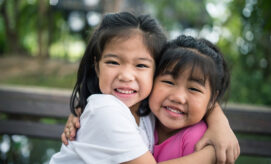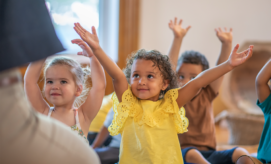In our work as early learning professionals, helping children to learn social and emotional skills is just as critical as academic instruction. Young children are actively expanding their emotional intelligence and practicing foundational skills for relationship-building and forming friendships. One of the most important of these foundational skills is empathy.
NAEYC reminds us that “modeling and teaching empathy— concern for others’ feelings—is an important part of being an effective, culturally competent teacher.”
What is Empathy?
An article in Young Children, written by early learning experts Valerie Quann and Carol Anne Wien, defines empathy as “the capacity to observe the feelings of another and to respond with care and concern for that other…[or] kindness toward another when there is a perceived or real sadness about that person.”
There are three kinds of empathy that educators often see in young children:
-
Proximal empathy which occurs when a child shows concerned care for a distressed classmate who is close by, though not having been involved in the classmate’s upset.
-
Altruistic empathy which occurs when a child offers concerned care in response to another child’s suffering, even when he or she noticed the suffering from afar.
-
Self-corrective empathy which occurs when a child offers concerned care in response to his or her own actions causing distress to another.
Why is Empathy Important in Early Learning?
Empathy strengthens community
In our diverse communities, being able to empathize with those from different cultures and backgrounds helps us to form stronger connections and deeper relationships. Edutopia explains, “As children learn empathy skills by communicating cross-culturally with their classmates, those skills will transfer to their lives in their community. The deeper relationships that result from strong empathy skills have the potential to strengthen a community and build trust. The effects of community extend far beyond the four walls of your classroom.”
Empathy sets children up for success
Researchers have found that empathy in young children is a building block for their future success. A study from Duke and Penn State that followed its participants from kindergarten into adulthood found that those who displayed empathy in kindergarten, by sharing and helping other children, were more likely to graduate from high school and have full-time jobs.
Empathy supports academic achievement
Researchers have explored the links between an empathy curriculum and academic achievement, and have found a positive correlation between the two. An article from tolerance.org describes the positive effects of empathy on learning. The article notes that children who learn in more empathetic environments have better self-esteem, feel more supported, are less stressed, are more successful in academics. They observe that“kids do better in a culture of caring.”
How Can We Teach Empathy?
-
Talk about it: By helping children understand what empathy looks like, you can help prepare them to show it. You can say things like, “you saw that your friend was sad, and so you brought him his favorite toy! That made him so happy!” These conversations help children to understand what it means to be supportive of their peers and to see the positive impact of their actions.
-
Model it: Children are constantly observing what we say and do. By demonstrating empathetic and kind behavior, we can help them to learn what it looks like to be caring and compassionate towards their peers.
-
Document it: Take photos of children interacting with their friends, and print out photos showing them doing something kind. Share the photo with the children at circle time, or by hanging it in the classroom (at their level, so they can see it). This will give children a chance to reflect on that experience, to remember how it felt, and to understand the positive impact of their kindness.
At what age does empathy begin?
The experience of empathy varies, based on a child’s age and developmental stage. Infants and toddlers demonstrate a simple compassion for others, while children who are older have a more developed understanding of cause and effect, making them better able to understand the impact of empathy on others.
Infants & Toddlers
Some argue that empathy is difficult for young children to grasp, as their brains are still developing. However, in your own practice, you have likely observed children as young as infants demonstrating kindness and empathy towards their peers. Infants and toddlers often display concern for their peers by showing distress when another child is upset and may even reach out to provide comfort.
An example of this early empathy occurs when a toddler sees a friend fall down and cry and then becomes noticeably concerned, even looking over at a teacher for help. We might also see a toddler offer a toy or stuffed animal to comfort a child who is crying when parents leave after drop-off.
Preschool & Pre-K
The Young Child article explains, “the child must learn to identify a wide range of emotional states in others. Further, the child must acquire the ability to anticipate what kinds of action will improve the emotional state of the other.” Older children, because of their more advanced understanding, will be able to respond with more thoughtful and intentional compassion. Additionally, because of their more developed language skills, they will be able to engage in more advanced conversations about feelings. Through conversation, they will be able to talk about how they are feeling and understand the experiences of others.
Resources for Further Exploration





